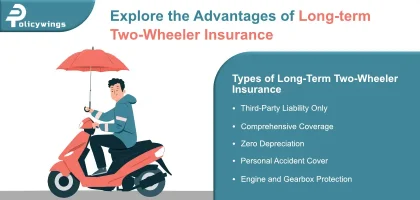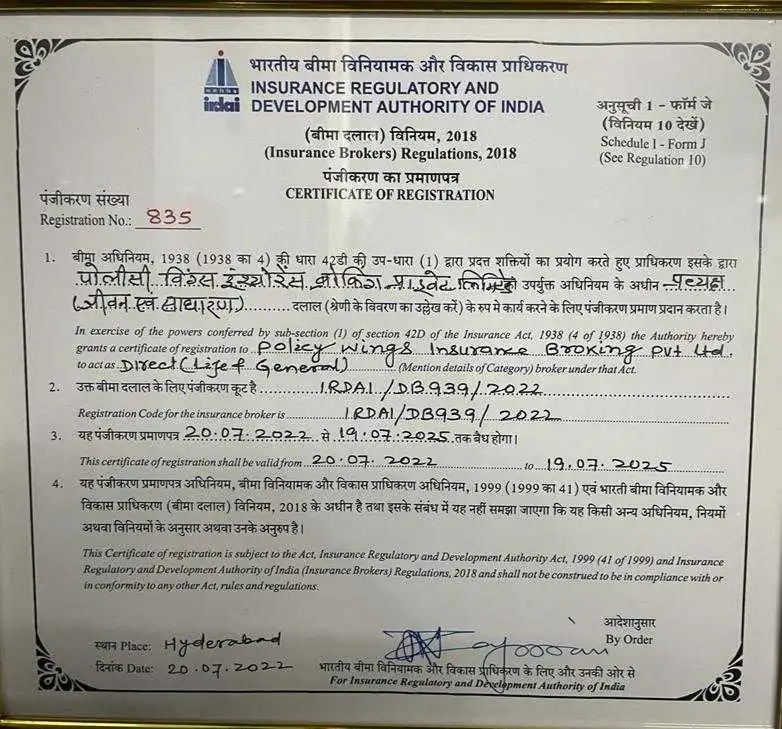Bike Insurance
Bike Insurance
We all know that two-wheeler insurance is mandatory on the roads of India. But most people don’t know what it actually means. This is the policy which each and every person in this country needs to purchase. There are several reasons why you should make sure you have a two-wheeler insurance policy before commencing your journey in India.
This post will cover all aspects of two-wheeler insurance in India and help you understand what it means and make sure you’re fully protected when riding your scooter, motorcycle or moped in India.
What exactly is Bike Insurance?
Bike Insurance can be defined as a legal contract between an individual (named the policyholder) and an insurance provider wherein the insurance provider covers the expenses made by the former party in case any loss or damage is sustained to or by the policyholder’s insured vehicle during the insurance policy tenure. The covered damage sustained to the insured vehicle includes but is not limited to theft, natural disasters, accidents, man-made disturbances like riots, vandalism and others. The insured vehicle’s covered damage includes any third-party responsibility resulting from an accident caused by the insured vehicle’s fault.
The coverage of the two-wheeler insurance also depends on the insurance policy purchased – standalone own-damage bike insurance, third-party liability policy, and comprehensive policy. The first one only covers the damage sustained by the insured vehicle while the second one covers the third-party liabilities towards any party who sustained damage or loss due to the fault of the insured two-wheeler. The last one, as the name suggests, offers complete coverage by combining both these policies into one. For maximum non-stop coverage, it is important to do your bike insurance renewal on time.
What are the types of Bike Insurance?
Here are the types of bike insurance policies available in the Indian market today:

Third-party liability insurance is mandatory for every two-wheeler when travelling on the roads of India. This policy covers any third-party liability that arises from any damage or loss suffered by a
third party caused by the vehicle covered by the insurance policy. This policy does not cover any loss or damage suffered by the insured vehicle during an accident.

Standalone own-damage insurance covers all the damages or loss sustained by the insured vehicle in case of any accident, man-made disasters, natural disasters, theft and other situations. However, this policy does not cover any liabilities caused by the insured vehicle towards any third party.

Comprehensive insurance policies offer the most complete insurance coverage available to two-wheelers. It offers coverage against third-party claims as well as any loss or damage sustained by the insured vehicle. Additionally, the policyholder can choose to add-ons to its base coverage which increases the scope of coverage. The most commonly purchased add-ons include emergency road assistance and zero depreciation cover. The only downside of these policies is that they are more expensive than standalone own-cover or third-party liability plans but given the amount of coverage it provides, can be justified.
Other than these basic types of two-wheeler insurance policies, here is another recent addition:
● Long Term Bike Insurance
Long-term bike insurance covers your two-wheeler for a period of 2 or 3 years in a single insurance policy. The highlight of these plans is that you can purchase long-term bike insurance online and receive a significant amount of discounts on your premium as well, as it saves you the time and effort of renewing your policies frequently.
Why should I Buy Bike Insurance?
Here are the reasons why you should consider purchasing a bike insurance policy:
● Mandatory
What most people don’t know is that it is mandatory for everyone to have third-party bike insurance while driving in India. In most cases, if you fail to maintain proper bike insurance on your vehicle, then the traffic police will nab you and slap a hefty amount of penalties on you. Having valid third-party bike insurance while driving can save you a good amount of penalties from the traffic police.
● Financial Immunity
Having a two-wheeler insurance policy provides you with the financial immunity that in case you are liable for an unfortunate accident causing damages to any third-person property, your insurance provider will settle the amount on your behalf. The financial insurance that comes with scooter insurance is one that makes you feel secure and safe whenever you are heading out somewhere.
● Personal Injuries are Taken Care of
Your motorcycle insurance policy will cover you in case of an accident, but given that you have the right coverage. If your existing policy does not cover your own damage, then it is essential to get comprehensive bike insurance instead. A standalone own-damage coverage will provide you with
the peace of mind that your vehicle as well as your personal injuries will be taken care of by your insurance provider in case you have been involved in an unfortunate accident.
● Affordable
Most people think 2-wheeler insurance is something very expensive but they really are not. The truth of the matter is that the price of bike insurance can change depending on the type of policy you choose and what coverage you need in your policy. You may think that all bike insurance policies cost the same or much more than car insurance but this is not true. All good insurance companies offer comprehensive plans, which offer full protection against third-party claims and offers standalone coverage at affordable rates. Moreover, if you decide to purchase long-term two-wheeler insurance online, you can enjoy discounts on premiums.
● Roadside Assistance
One of the most sought-after bike insurance add-ons is emergency roadside assistance. Pretty much as the name suggests, this optional cover provides you with roadside aid in the case of emergency bike breakdowns.
What are the Bike Insurance Add-ons?
Bike insurance add-ons are optional coverage plans that the policyholder can buy over the basic insurance plan to increase the scope of coverage.
Here are some of the most commonly purchased bike insurance add-on covers:
1. Roadside Assistance Cover
This add-on provides the policyholder with a mechanic in the event of a vehicle breakdown on the road.
2. Zero Depreciation
This add-on removes the depreciation effect on the vehicle which allows the policyholder to file a bigger claim. Most insurance companies set a limit of zero depreciation claims in a calendar year. So, it is important to check that amount before buying the add-on.
3. Consumables Cover
This add-on provides coverage for consumables like fuel filters, grease, nut, bolt, oil filter and others that the base scooty insurance policy does not cover.
4. Key Loss Cover
This add-on assists the policyholder if he or she happens to misplace the key to the insured vehicle. The insurance provider also provides a spare key to the policyholder in a limited time frame.
5. Engine Safe Cover
The engine is the heart of a two-wheeler, and this add-on offers complete protection for it. If you are living in a flood-prone area or just somewhere where water logging is an issue, this add-on is a must-have for you.
6. NCB Protection Cover
NCB stands for No Claim Bonus. This bonus reduces the premium amount payable by the policyholder every claim-free year. This add-on makes sure the policyholder receives the NCB bonus even after he or she has filed an insurance claim.
7. Daily Allowance Cover
This add-on cover offers the policyholder a set amount of money every day when the insured two-wheeler is out for repair or loss.
How to File Bike Insurance Claim?
Here is a step-by-step breakdown of the claim filing process for bike insurance:
1. Following an accident, you must notify your two-wheeler insurance provider as soon as possible.
2. The company may recommend that you take your two-wheeler to an approved network garage. This can offer you cashless repairs. If you don’t have any nearby network garage, you can take your bike to any local garage and then file for a reimbursement claim.
3. A surveyor from the firm may come to the garage to inspect the two-wheeler’s condition. He will write a report and send it to the firm.
4. Your two-wheeler will be fixed after the insurance provider’s approval.
5. If somebody else is hurt or his car or belongings is harmed as a result of your two-wheeler, a third-party claim needs to be filed, and so, an MCR should therefore be lodged at the local police station.
6. If your two-wheeler is stolen, register a police FIR as soon as possible and notify your insurance provider.
Bike Insurance Exclusions
Here are the common bike insurance exclusions:
1. Driving while under intoxication
2. Unauthorised driving
3. Negligent accidents
4. Consequential damages following an accident
5. Excluded add-on covers
Note: This is a generic set of exclusions. It is advisable to check with your insurance provider to get a complete set of exclusions.
Conclusion
Once you’ve read through everything here, you should be fully informed of how two-wheeler insurance works in India. Most importantly, you should also be well on your way to choosing a policy that offers the perfect blend of coverage and benefits for your particular needs. You would also need to do a timely two-wheeler insurance renewal in order to get continuous coverage.
Frequently Asked Questions
The Indian Government has made it essential for every two-wheeler owner to obtain insurance coverage under the 1989 Motor Vehicles Act.
In order to get cashless claims, you need to get your two-wheeler fixed in a network garage and get it checked by a surveyor. Once your insurance provider approves your claim, you can get cashless repairs for your two-wheeler.
Cashless bike insurance claims require the policyholder to get to repair his or her bike in a network garage, which will be compensated by the insurance provider directly, while reimbursement claim means the policyholder will need to pay from their wallets for the repair and then file a refund to their insurance provider.











